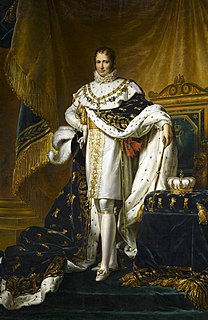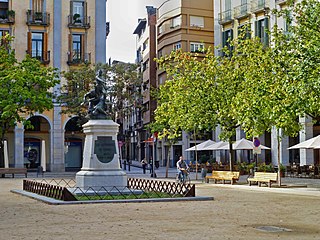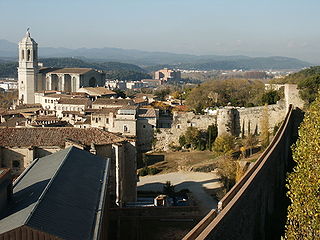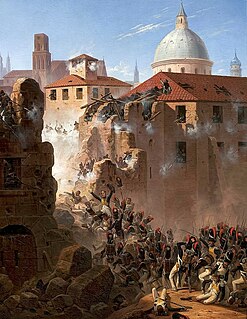 W
WThe Battle of Bailén was fought in 1808 between the Spanish Army of Andalusia, led by Generals Francisco Castaños and Theodor von Reding, and the Imperial French Army's II corps d'observation de la Gironde under General Pierre Dupont de l'Étang. This battle was the first open-field defeat of a Napoleonic army. The heaviest fighting took place near Bailén, a village by the Guadalquivir river in the Jaén province of southern Spain.
 W
WThe Battle of Benavente was a cavalry clash in which the British cavalry of Lord Paget defeated the elite Chasseurs à cheval of the French Imperial Guard during the Corunna Campaign of the Peninsular War. The French chasseurs were broken and forced into the River Esla; their commanding officer, General Lefebvre-Desnouettes, was captured. The action was the first major incident in the British army's harrowing retreat to the coast and ultimate evacuation by sea.
 W
WThe Battle of Burgos, also known as Battle of Gamonal, was fought on November 10, 1808, during the Peninsular War in the village of Gamonal, near Burgos, Spain. A powerful French army under Marshal Bessières overwhelmed and destroyed the outnumbered Spanish troops under General Belveder, opening central Spain to invasion.
 W
WThe Battle of Cabezón was an engagement early in the Peninsular War on 12 June 1808 between a small Spanish militia force, based in Valladolid, and a detachment of Marshal Bessières' French Army Corps under General Lasalle.
 W
WThe Battle of Espinosa de los Monteros was a battle of the Napoleonic Wars, fought on 10 and 11 November 1808 at the township of Espinosa de los Monteros in the Cantabrian Mountains. It resulted in a French victory under General Victor against Lieutenant General Joaquín Blake's Army of Galicia.
 W
WThe Battle of Medina de Rioseco, also known as the Battle of Moclín, was fought during the Peninsular War on 14 July 1808 when a combined body of Spanish militia and regulars moved to rupture the French line of communications to Madrid. General Joaquín Blake's Army of Galicia, under joint command with General Gregorio de la Cuesta, was routed by Marshal Bessières after a badly coordinated but stubborn fight against the French corps north of Valladolid.
 W
WThe Battle of Sahagún was a cavalry clash at Sahagún, Spain, in which the British 15th Light Dragoons (Hussars) defeated two regiments of French cavalry during the Corunna Campaign of the Peninsular War. Losses to one of the French regiments were so heavy that it was subsequently disbanded. The action marked the final phase of the British army's advance into the interior of Spain, before they began their harrowing retreat to the coast and ultimate evacuation by sea.
 W
WThe Battle of Somosierra took place on November 30, 1808, during the Peninsular War, when a combined Franco-Spanish-Polish force under the direct command of Napoleon Bonaparte forced a passage through against Spanish guerrillas stationed at the Sierra de Guadarrama which was shielding Madrid from direct French attack. At the Somosierra mountain pass, 60 miles north of Madrid, a heavily outnumbered Spanish detachment of conscripts and artillery under Benito de San Juan aimed to block Napoleon's advance on the Spanish capital. Napoleon overwhelmed the Spanish positions in a combined arms attack, sending the Polish Chevau-légers of the Imperial Guard at the Spanish guns while French infantry advanced up the slopes. The victory removed the last obstacle barring the road to Madrid, which fell several days later.
 W
WThe Battle of Tudela saw an Imperial French army led by Marshal Jean Lannes attack a Spanish army under General Castaños. The battle resulted in the complete victory of the Imperial forces over their adversaries. The combat occurred near Tudela in Navarre, Spain during the Peninsular War, part of a wider conflict known as the Napoleonic Wars.
 W
WThe First Battle of Valencia was an attack on the Spanish city of Valencia on 26 June 1808, early in the Peninsular War. Marshal Moncey's French Imperial troops failed to take the city by storm and retreated upon Madrid, leaving much of eastern Spain unconquered and beyond the reach of Napoleon.
 W
WThe Bayonne Statute or Bayonne Constitution or Bayonne Charter, officially in the original document Constitution, and officially in French, Acte Constitutionnel de l’Espagne—was a constitution or a royal charter approved in Bayonne, France, 6 July 1808, by Joseph Bonaparte as the intended basis for his rule as king of Spain.
 W
WThe two Battles of the Bruch (Spanish: Batallas del Bruch; Catalan: Batalles del Bruc) were engagements fought successively between French columns commanded by Brigadier General François de Schwarz and General of Division Joseph Chabran, and a body of Catalan volunteers and mercenaries led by General Antoni Franch i Estalella and Joan de la Creu Baiget, during the Peninsular War. The result of these battles and actions fought at El Bruc, near Barcelona, Catalonia, between 6–14 June 1808 was a Spanish victory. The Spanish also captured a French Imperial Eagle, adding to defeat a humiliation for the French army.
 W
WThe Battle of Cardadeu on 16 December 1808 saw an Imperial French corps led by Laurent Gouvion Saint-Cyr assault a Spanish force commanded by Juan Miguel de Vives y Feliu and Theodor von Reding. Saint-Cyr won the engagement by forming most of his troops into gigantic attack columns and smashing through the Spanish lines. Cardedeu is located 17 kilometres (11 mi) northeast of Barcelona, Spain. The action occurred during the Peninsular War, part of the Napoleonic Wars.
 W
WThe Dos de Mayo or Second of May Uprising of 1808 was a rebellion by the people of Madrid against the occupation of the city by French troops, provoking repression by the French Imperial forces.
 W
WThe Battle of Gerona on 20 and 21 June 1808 saw an Imperial French division led by Guillaume Philibert Duhesme try to overrun a Spanish garrison commanded by Lieutenant Colonels O'Donovan and O'Daly. The French assault failed and the attackers withdrew. Girona is located about halfway between the Franco-Spanish border and Barcelona on the Autovía A-7. The action occurred during the Peninsular War, part of the Napoleonic Wars.
 W
WThe Second Siege of Gerona was the second unsuccessful French attempt to capture the city of Girona during the Peninsular War, part of the Napoleonic Wars. Girona is located near the present-day Autovía A-7, about halfway between the Franco-Spanish border and Barcelona, in Catalonia.
 W
WIn the Battle of Mansilla or Battle of Mansilla de las Mulas on 30 December 1808 an Imperial French corps led by Nicolas Soult caught up with a Spanish corps commanded by Pedro Caro, 3rd Marquis of la Romana. Soult's cavalry under Jean Baptiste Marie Franceschi-Delonne overran la Romana's rear guard led by General Martinengo. Mansilla de las Mulas is a town located 17 kilometres (11 mi) southeast of León, Spain. The combat occurred during the Peninsular War, part of the Napoleonic Wars.
 W
WThe Battle of Molins de Rei or Battle of Molins de Rey or Battle of Molins del Rey saw an Imperial French corps led by Laurent Gouvion Saint-Cyr attack a Spanish army temporarily led by Theodor von Reding and the Conde de Caldagues because its commander Juan Miguel de Vives y Feliu was absent. Saint-Cyr outmaneuvered his opponents, distracting them with a false attack in front while sending the bulk of his force across Llobregat River in a turning movement around the Spanish right flank. The Spanish defensive lines crumbled and the French captured 1,200 soldiers, all the Spanish artillery and Caldagues himself. The Peninsular War engagement was fought near Molins de Rei, located 15 kilometres (9 mi) west of Barcelona, Catalonia, Spain.
 W
WThe Tumult of Aranjuez was an uprising led against King Charles IV that took place in the town of Aranjuez, Spain, on 17–19 March 1808. The event, which is celebrated annually in the first week of September, commemorates the fall of the monarch and the subsequent accession of his son Ferdinand VII.
 W
WThe Siege of Roses or Siege of Rosas from 7 November to 5 December 1808 saw an Imperial French corps led by Laurent Gouvion Saint-Cyr invest a Catalan and Spanish garrison commanded by Peter O'Daly. After a siege lasting a month in which the haven and town of Roses was captured and the nearby Trinity Castle invested by over 13,000 French and Italian infantry, artillery and cavalry with heavy siege trains on the hills above, the Citadel was surrendered to the Napoleonic forces. Roses (Rosas) is located 43 kilometres (27 mi) northeast of Girona, Catalonia, Spain. The action occurred during the Peninsular War, part of the Napoleonic Wars.
 W
WThe Capture of the Rosily Squadron, also known as the Battle of Poza de Santa Isabel, took place on 14 June 1808, in Cadiz, Spain, during the uprising against the French invaders. Five French ships of the line and a frigate were in the port, having remained there under blockade since the Battle of Trafalgar nearly three years earlier. After an engagement with the Spanish lasting five days, French Admiral François Étienne de Rosily-Mesros surrendered his entire squadron with the four thousand seamen then on board.
 W
WThe battle of Valdepeñas was a popular uprising that took place on 6 June 1808, at the beginning of the Spanish War of Independence, in the town of Valdepeñas, Ciudad Real, Castile-La Mancha. Valdepeñas is on the main road from Madrid to Andalusia.
 W
WThe First Siege of Zaragoza was a bloody struggle in the Peninsular War (1807–1814). A French army under General Lefebvre-Desnouettes and subsequently commanded by General Jean-Antoine Verdier besieged, repeatedly stormed, and was repulsed from the Spanish city of Zaragoza in the summer of 1808.